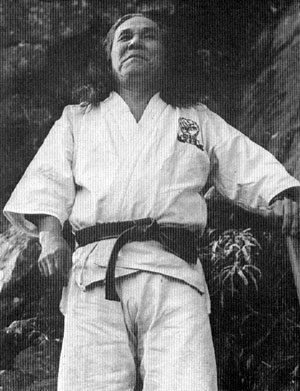|
|
Okinawan/Japanese
Kanryo Higaonna
Kanryo Higaonna returned to Naha, Okinawa, in 1883, and introduced Naha-Te, a mixture of the local fighting style "tode", and the blend of Gongfu he learned in China. He never referred to the Gongfu he learned by style specifics, lending credence to the theory that he blended several styles to form his own. He only stated that he learned "kenpo". He became one of the preeminent Masters in Naha. He incorporated several kata that he learned in China into his system. These kata included a version of Sanchin (reportedly Miyagi introduced his own version later ), Sanseru, Saifa, Niseishi, Seiunchin, Shisochin, Kururunfa, Sesan, Seipai, and Peichurrin (Suparempi). At the risk of infuriating traditionalists, I would suggest that goju (in everything but name) was created by Higaonna Sensei, not Miyagi Sensei.
Chojun Miyagi
 |
Chojun Miyagi was the first Okinawan Master to give his style a name other than the name of the city he taught out of. He expanded Higaonna Sensei's Naha-Te dramatically. Legend tells that a student of his went to Japan to represent Naha-Te before the emperor. A courtier asked Miyagi's representative what the name of his incredible style was. (All the Japanese and Chinese systems represented had specific style names.) The representative was in a bad position. He did not want to appear a barbarian in court, so he announced that his style was called "half hard".
Upon his return to Naha, he told his Master what had happened. Miyagi agreed that giving the system a name was important in his work to spread his teachings. He changed the name to Goju. Miyagi introduced several kata into the system. His kata include his own version of Sanchin, Geki Sai (Dai Ichi, and Dai Ni), and Tenshoa.

|
Gogen Yamaguchi
Gogen Yamaguchi was a disciple of Miyagi Sensei. He promoted the art of Goju-Ryu in Japan, and formed the Japan Karate-Do Federation Goju-Kai. Yamaguchi is credited with the formation of the jiyu-kumite that is the basis of sport karate today. Captured and held by the Russians in 1939, he was released and returned to Japan in 1947.
Sensei Yamaguchi introduced the Taikyoku (or first course) katas. These katas were originally created by Gichin Funakoshi, founder of Shotokan karate. These katas have been modified to reflect the elements of Goju including the use of sanchin and shiko dachi. The Taikyoku that Sansei uses include Taikyoku Jodan Uke, Taikyoku Chudan Uke, Taikyoku Gedan Uke, Taikyoku Empi-Go, and Taikyoku Mawashi Uke. |
 |
|
|
|





